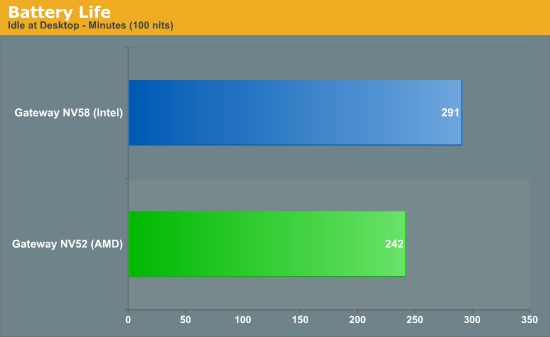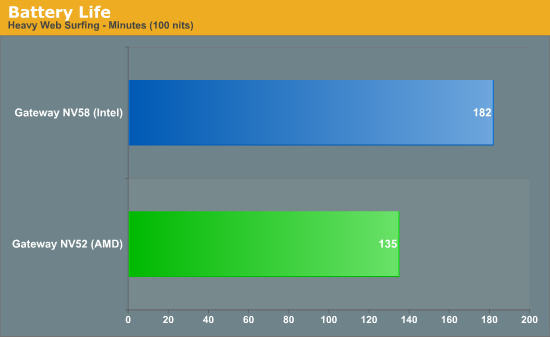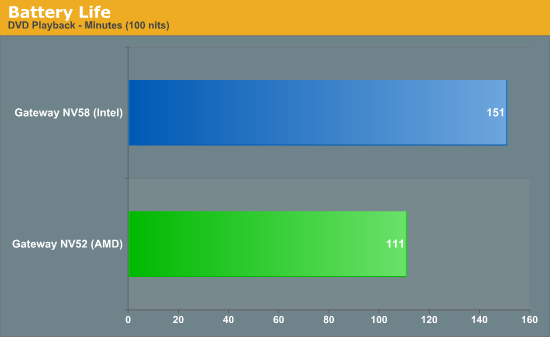AMD vs. Intel: Battery Life Investigated
by Jarred Walton on August 5, 2009 5:00 PM EST- Posted in
- Laptops
AMD vs. Intel: Battery Life Investigated
Both laptops used identical power saving settings under Windows Vista's "Balanced" plan (with some minor tweaks to the defaults on both systems). We ran five different test scenarios, ranging from best-case idle battery life at the Windows desktop to a far more taxing DVD/x264 playback results, along with two different Internet surfing benchmarks. One Internet benchmark represents a "light" load while the other has far more Flash content and represents a "heavy" load. We set both LCDs to 100 nits brightness (40% in this case) and completed a couple charge/discharge cycles to break in the battery before beginning our tests. Here are the results.





Considering these systems are as close as we can get to "identical", AMD takes a real pounding in battery life testing. The closest result (the idle test) has the Intel platform providing 20% more battery life, while the best Intel results (DVD playback and heavy web surfing) give about 35% more battery life. Averaging all five results, the Intel-based NV58 delivered 28% more battery life than the AMD-based NV52. Ouch.
Obviously, despite having identical clock speeds there are some real differences between the two processors. For one, Intel's T6500 is a 45nm part compared to the 65nm QL-64 (not that AMD has 45nm parts yet). We also don't know how much of an impact the various chipset and motherboard components might have. What we do know is that AMD's current mobile processor lineup consists of dual-core CPUs that range from 2.00GHz up to 2.50GHz, with most having a 31W TDP to 35W TDP rating; the TK-42 is a 20W 1.60GHz part and the QL-62 is a 25W 2.00GHz part. Intel on the other hand has many more options. 10W dual-core CPUs are available with clock speeds of 1.06GHz to 1.60GHz; 17W chips have clock speeds ranging from 1.33GHz to 2.13GHz; 25W processors start at 2.26GHz and end at 2.66GHz; and the 34/35W parts cover the gamut from 1.60GHz all the way up to 3.06GHz… and that's just the Core 2 Duo parts! Pentium Dual-Core, Core 2 Quad, and Core 2 Extreme parts are also available to flesh out the spectrum. Then again, some of those parts cost twice as much as the Gateway NV52 just for the CPU.
When Intel released Banias and the Centrino platform in March 2003, they started a revolution in their approach to mobile processor design. Power and efficiency became the focus rather than pure clock speed, and the result has been much better mobile processors when it comes to performance per Watt. Unfortunately for AMD, they appear stuck with the old way of doing things: build a generic architecture and then optimize it for power requirements on mobile chips. Essentially the same core K8 architecture that launched in 2003 continues to power AMD's mobile offerings, and while the ensuing shrink to 65nm has helped there's still a lot of ground to make up. AMD-based laptops are still more than fast enough for most users -- and let's make this clear, a $500 dual-core AMD laptop is tons faster than anything using Intel Atom (though it uses more power, obviously) -- but Intel has the upper hand. It's unfortunate there's not more competition in the mobile processor space, or we might start really start to see prices drop!
For now, if you're looking for an inexpensive laptop (not a netbook), you need reasonable battery life, and you don't care about graphics performance we suggest saving up the extra $50-$100 for an Intel-based system.










80 Comments
View All Comments
zsdersw - Thursday, August 6, 2009 - link
"Battery life should not be a concern at all for most laptop users, because most people use their laptops at home"Apparently you've never heard of the business world.
anactoraaron - Thursday, August 6, 2009 - link
"So, what is the point in paying a higher price premium for an Intel laptop, because it has a longer battery life?"For me, I needed a laptop that I can take with me anywhere (out of state, etc) and be able to run photoshop cs3 and run it well. It is common knowledge that photoshop favors intel's core architecture (both dual and quad) and from my own experience on mobile platforms intel beats amd by 100-300% depending on what you are doing. Would I pay more for 300% improvement? Uh... yes.
I also would like to say that the current photoshop benchmark is nice, but it should be treated as just any other benchmark - meaning real life usage may differ. One of the things I do alot in photoshop is make contact sheets (used as proof sheets, flattened and saved as pdf's) - which are VERY cpu intensive. Try crunching 300 images on 54 images/sheet making 6 sheets and time the results. This type of benchmark will run for up to 15 minutes on an older core 2 system. My q8400 does 1 sheet per minute- which I still think is fast. Just a suggestion.
JarredWalton - Wednesday, August 5, 2009 - link
Most people don't buy a laptop because it's smaller in my experience; they buy them because they're mobile. Anyway, even if you don't want to have better battery life, why pay the price premium for Intel? Well, 30% better performance is something useful I'd think... unless you plan to play lots of games with the IGP.medi01 - Thursday, August 6, 2009 - link
Nope. At least not me. I have 2 laptops and 1 PC at home. All 3 stay at home all the time.strikeback03 - Thursday, August 6, 2009 - link
Mobile doesn't necessarily mean it leaves the house, but you can more easily move a laptop from the office to the living room to the kitchen table to the hammock outside if needed. In this class of notebook (15.6") mobility might be less of a concern, but the platform differences should hold up through all segments, including ones where battery life is a larger factor in which unit to purchase.Jamahl - Wednesday, August 5, 2009 - link
a few benchmarks of fps in gaming would have been nice if only to show that the intel is awful and the amd is capable.pjtomtai - Thursday, August 6, 2009 - link
Who games on IGP? There ARE laptops with discrete for that purpose. 80% of users don't game, while 80% depend on a solid laptop with longer battery time for work/life on move.xrodney - Thursday, August 6, 2009 - link
Well i have expensive gaming machine, but still play games on notebook time from time. Not always my gaming machine is available for gaming {rendering etc} so i am using notebook instead or i am not near to it at all. And from my personal experience many people around me is doing same.JarredWalton - Thursday, August 6, 2009 - link
I've run all the benchmarks; I'm just writing the main article at this point and it should be done for Friday. In terms of gaming, as I mentioned in this piece, the AMD solution is substantially faster - anywhere from 50% to 200% faster, with the average being around 125% faster. (The 50% comes from Empire: Total War, incidentally.) To be honest, I was actually surprised at the number of games the Intel IGP could manage to *load* - last time I looked at that on a GMA IGP there were only a few modern games that would try to load at all. LOLJeffk464 - Thursday, August 6, 2009 - link
pshh, games belong on desktops.